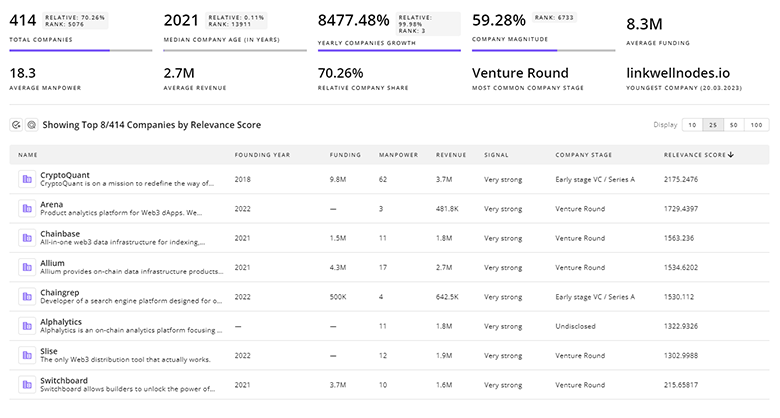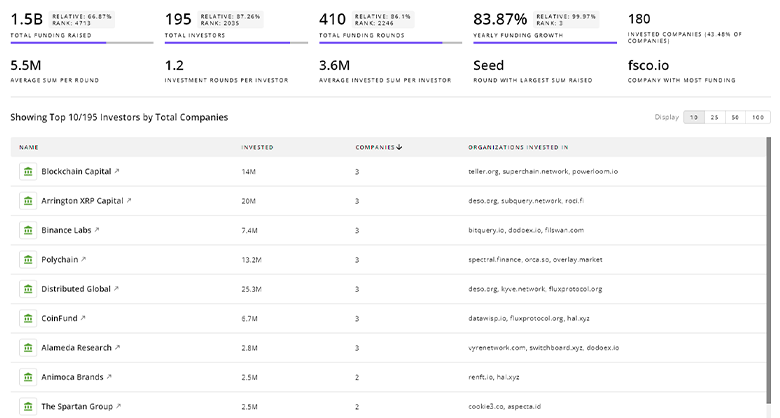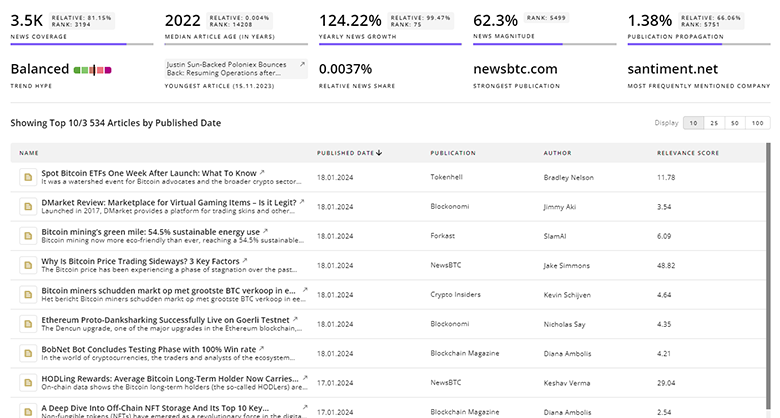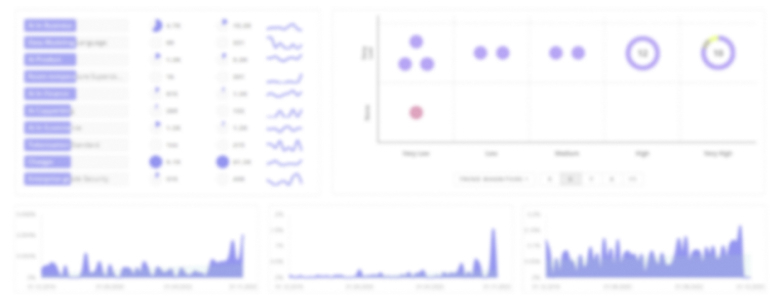
Cervical Cancer Report
: Analysis on the Market, Trends, and TechnologiesThe global response to cervical cancer is undergoing a measurable shift from late-stage treatment to high-impact prevention and earlier, decentralized detection; the internal cervical cancer trend report records $10.10B total funding raised across the topic and a 160.09% increase in companies over five years, indicating active commercialization and delivery risk/reward for investors. This report synthesizes patent, company, market, and news data to show where capital, technology, and programmatic priorities align and where gaps persist.
We updated this report 15 days ago. Noticed something’s off? Let’s make it right together — reach out!
Topic Dominance Index of Cervical Cancer
The Topic Dominance Index trendline combines the share of voice distributions of Cervical Cancer from 3 data sources: published articles, founded companies, and global search
Key Activities and Applications
- Early detection and screening expansion: scaling HPV DNA/mRNA testing and self-sampling to increase population coverage and reduce diagnostic delay; Aptima’s HPV mRNA assay is explicitly positioned for higher specificity in clinical workflows Aptima.
- Point-of-care and decentralized diagnostics: smartphone-based colposcopy, rapid antigen/CRISPR kits, and single-drop blood serology are being commercialized to move screening into low-resource settings MobileODT Abviris Deutschland GmbH.
- At-home and self-sampling solutions: devices and kits designed for privacy and uptake (home collection with lab testing) to increase screening participation Aprovix AB.
- Non-surgical precancer care and treatment: portable cryoablation and thermocoagulation platforms for on-site treatment of precancerous lesions reduce referral loss and costs Ananya Health.
- Digital care pathways and telecolposcopy: image capture, remote expert review, and case management platforms that integrate diagnostics with treatment navigation to reduce time-to-care MobileODT.
(So what) These activities converge on three business levers: increase screening uptake, convert screening to immediate treatment where appropriate, and reduce downstream costs from advanced disease. Firms that bridge affordable hardware, validated assays, and digital workflows capture the largest addressable outcomes.
Emergent Trends and Core Insights
- AI-enabled image analysis is moving from R&D into clinical pilots for automated triage, promising faster reading and lower pathology bottlenecks; NTL HEALTHCARE’s CerviCARE AI exemplifies exportable AI screening systems NTL HEALTHCARE.
- Self-sampling and at-home kits are becoming regulatory-validated channels for population screening; FDA approvals and commercial launches make direct-to-consumer and clinic-partnered models viable revenue paths getteal.com.
- Liquid biopsy and serology for HPV-related cancers are emerging as whole-body screening options that can detect extra-cervical HPV malignancies and enable monitoring; Abviris’ Prevo-Check points to rapid clinical workflows for one-drop screening Abviris Deutschland GmbH.
- Shift toward molecular specificity: mRNA and epigenetic marker assays seek to reduce false positives inherent to DNA-only testing, thereby lowering unnecessary interventions and system costs CC Diagnostics.
- Global equity momentum: programmatic initiatives and mobile-delivery models (e.g., CureCervicalCancer’s mobile clinics) are central to reaching WHO elimination targets and present partnership opportunities for device and test vendors CureCervicalCancer.
(So what) Together, these trends reshape unit economics: better specificity and decentralized care lower cost per effectively prevented cancer, improving payer willingness to reimburse and governments to scale national programs.
Technologies and Methodologies
- Molecular assays (HPV mRNA, epigenetic markers): provide finer risk stratification versus DNA tests, reducing follow-up procedures Aptima.
- CRISPR-based rapid assays: promise fast, low-cost, nucleic-acid detection usable at point of care and for self-collected samples Cervixel.
- AI/ML image analysis and telecolposcopy: enable automated triage of colposcopic images and remote specialist review, increasing throughput in limited-resource systems MobileODT.
- Liquid biopsy and serology (HPV immunoassays): expand screening beyond the cervix, offering a blood-based adjunct that can flag HPV-related tumors across anatomical sites Abviris Deutschland GmbH.
- Low-cost device-enabled cryo/thermoablation: single-visit treatment devices reduce loss-to-follow-up and program costs in community settings Ananya Health.
(So what) The most investable technology combinations pair higher-specificity assays with scalable sample collection (self-sampling or finger-prick) and digital connectivity for follow-up—this stack reduces unit cost and improves health-system uptake.
Cervical Cancer Funding
A total of 260 Cervical Cancer companies have received funding.
Overall, Cervical Cancer companies have raised $11.2B.
Companies within the Cervical Cancer domain have secured capital from 845 funding rounds.
The chart shows the funding trendline of Cervical Cancer companies over the last 5 years
Cervical Cancer Companies
- NTL HEALTHCARE: South Korea–based femtech firm with a long history in cervical screening and an AI screening product, CerviCARE AI. NTL’s export focus and embedded AI position it for partnerships with national screening programs seeking automated reading and telemedicine integration.
- Aprovix AB: Swedish medtech targeting self-sampling for HPV testing via the CE-marked Qvintip device. Its at-home accuracy claims and device registration make it a strategic fit for private-pay and national self-sampling rollouts.
- Ananya Health: Early-stage US company developing a portable cryoablation platform that eliminates dependence on cryogen gas. The product targets clinics in low-resource settings and community health centers to enable same-visit treatment of precancerous lesions.
- Cervixel: Lithuania-based startup developing CRISPR-powered rapid diagnostic kits for pre-cancerous cervical lesions suitable for decentralized use and home collection. Their approach shortens time-to-diagnosis and lowers lab burdens.
- Abviris Deutschland GmbH: German company commercializing HPV serology with a one-drop blood test (Prevo-Check) geared toward broad HPV-related cancer screening. The test enables rapid triage across HPV-driven malignancies beyond cervix, offering a novel screening vector for integrated programs.
(So what) These firms illustrate commercial strategies: device plus digital service (NTL, MobileODT), sample-collection optimization for population scale (Aprovix, Teal), point treatment to close the screen-to-treat loop (Ananya), and new biomarker modalities (Abviris, Cervixel).
Gain a better understanding of 1.8K companies that drive Cervical Cancer, how mature and well-funded these companies are.

1.8K Cervical Cancer Companies
Discover Cervical Cancer Companies, their Funding, Manpower, Revenues, Stages, and much more
Cervical Cancer Investors
Gain insights into 837 Cervical Cancer investors and investment deals. TrendFeedr’s investors tool presents an overview of investment trends and activities, helping create better investment strategies and partnerships.

837 Cervical Cancer Investors
Discover Cervical Cancer Investors, Funding Rounds, Invested Amounts, and Funding Growth
Cervical Cancer News
Gain a competitive advantage with access to 9.6K Cervical Cancer articles with TrendFeedr's News feature. The tool offers an extensive database of articles covering recent trends and past events in Cervical Cancer. This enables innovators and market leaders to make well-informed fact-based decisions.

9.6K Cervical Cancer News Articles
Discover Latest Cervical Cancer Articles, News Magnitude, Publication Propagation, Yearly Growth, and Strongest Publications
Executive Summary
Investment and program activity in cervical cancer are aligning behind three pragmatic priorities: increase screening coverage through self-sampling and decentralized modalities, improve specificity to reduce unnecessary interventions via mRNA and epigenetic testing, and convert screening into immediate, low-cost treatment with portable devices. Market signals—significant company growth (160% increase in companies), substantial total funding ($10.10B), and accelerating news coverage around diagnostics and access—indicate commercially viable pathways for stakeholders that integrate validated assays, affordable hardware, and digital care pathways. For payers and health systems, the imperative is clear: adopt integrated screening-treatment pilots that measure cost per cancer prevented, not just tests deployed; for investors, the highest-return opportunities sit at the intersection of validated biomarker assays, user-friendly collection devices, and software-enabled care orchestration.
We seek partnerships with industry experts to deliver actionable insights into trends and tech. Interested? Let us know!












